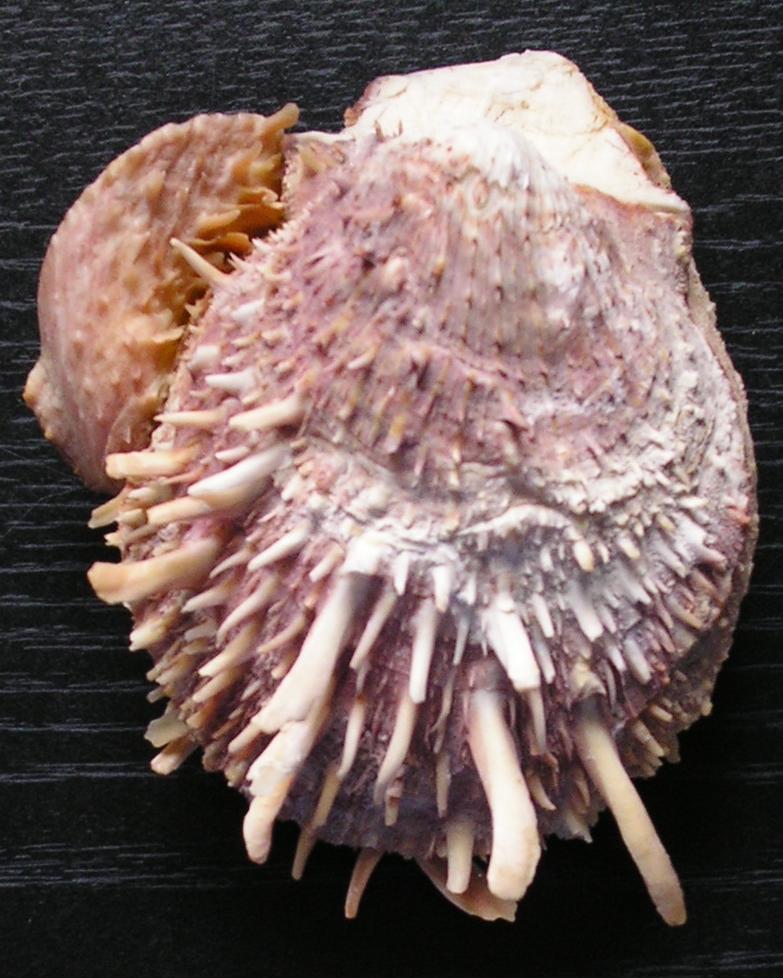- Spondylus
Taxobox
name = "Spondylus"

image_caption = "Spondylus sp."
regnum =Animal ia
phylum = Mollusca
classis =Bivalvia
ordo =Ostreoida
subordo =Pectinina
superfamilia =Pectinoidea
familia = Spondylidae
familia_authority = Gray, 1826
genus = "Spondylus"
genus_authority =Linnaeus , 1758
subdivision_ranks = Species
subdivision = See text."Spondylus" is a
genus ofbivalve mollusk s, the only genus in the family Spondylidae. As well as being the systematic name, "Spondylus" is the most often used common name for these animals, though they are also known as thorny oysters or spiny oysters.There are many
species of "Spondylus", and they vary considerably in appearance and range. They are grouped in the samesuperfamily as thescallop s, but like thetrue oysters (family Ostreidae) they cement themselves to rocks, rather than attaching themselves by abyssus . Their key characteristic is that the two parts of their shells are hinged together with a ball and socket type of hinge, rather than a toothed hinge as is more common in other bivalves."Spondylus" have multiple eyes around the edges of the shell, and they have a relatively well developed
nervous system . Their nervous ganglia are concentrated in theviscera l region, with recognisableoptic lobe s, connected to the eyes."Spondylus" shells are much sought after by collectors, and there is a lively commercial market in them.
History
Archaeological evidence shows that people in
Neolithic Europe were trading the shells of "Spondylus gaederopus" to make bangles and other ornaments as long as 5,000 years ago (Varna necropolis ). The shells were harvested from theAegean Sea but were transported far into the centre of the continent. In theLBK andLengyel culture , "Spondylus" shells from the Aegean Sea were worked into bracelets and belt-buckles."Spondylus princeps" are also found off the coast of
Ecuador , and have been important toAndean peoples sincepre-Columbian times, serving as offerings to thePachamama as well as some kind of currency. In fact much like in Europe the "Spondylus" shells also reached far and wide as pre-Hispanic Ecuadorian peoples traded them with peoples as far north as present-dayMexico and as far south as the centralAndes . TheMoche people of ancientPeru worshipped animals and the sea and often depicted "Spondylus" shells in their art. [Berrin, Katherine & Larco Museum. "The Spirit of Ancient Peru:Treasures from the Museo Arqueológico Rafael Larco Herrera." New York:Thames and Hudson , 1997.]pecies
*
Atlantic thorny oyster , "Spondylus americanus " Hermann, 1781
*Nude thorny oyster , "Spondylus anacanthus " Mawe, 1823
*European thorny oyster , "Spondylus gaederopus "Linnaeus , 1758
*Japanese spiny oyster , "Spondylus japonica "
*Pacific thorny oyster , "Spondylus princeps " Broderip, 1833
* "Spondylus calcifer " Carpenter, 1857
*Regal thorny oyster "Spondylus regius "
* "Spondylus tenellus " Reeve, 1856
* "Spondylus versicolor "
*Wright's thorny oyster , "Spondylus wrightianus "References
External links
* [http://www.unizd.hr/LinkClick.aspx?link=Ifantidis.pdf&tabid=1434&mid=1870 Spondylus Session Abstracts] Abstracts of a Session on Spondylus research at the 13th Meeting of the European Association of Archaeologists at Zadar, Croatia, September 2007
* [http://nighthawk.tricity.wsu.edu/museum/ArcherdShellCollection/Bivalvia/Spondylidae.html Information about Spondylus] from the website of the Gladys Archerd Shell Collection at Washington State University Tri-Cities Natural History Museum
* [http://home.earthlink.net/~aydinslibrary/MalacGp09.pdf Article on Spondylus artifacts] Article on the "notched Spondylus" Neolithic artifacts in EuropeBibliography
A full and constantly updated bibliography on " Spondylus sp." concerning Aegean, Balkan, European and American contexts is available at the blog-based forum of spondylus wordpress com
Pre-Hispanic trade in Spondylus seashells
* Shimada, Izumi. “Evolution of Andean Diversity: Regional Formations (500 B.C.E-C.E. 600). The Cambridge History of the Native People of the Americas. Vol. III, pt. 1. Ed. Frank Salomon & Stuart B. Schwartz. Cambridge: Cambridge University Press, 1999: 350-517, esp. "Mesoamerican-Northwest South American Connections", pp. 430-436.
Prehistoric Europe
* Paul Halstead, Spondylus shell ornaments from late Neolithic
Dimini , Greece: specialized manufacture or unequal accumulation? Antiquity 67 (Nr 256), 603–609.
* J. SHACKLETON/H. ELDERFIELD, Strontium isotope dating of the source of Neolithic European Spondylus shell artefacts, Antiquity 64, 1993, 312-315.
* N. SHACKLETON/C. RENFREW. 1970. Neolithic trade routes realigned by oxygen isotope analyses, Nature 228: 1970, 1062-5.
* Slavomir VENCL, Spondylove šperky v podunajskem Neolitů, Archeologicke Rozhledy 9, 1959, 699-742.
* VLADIMÍR PODBORSKÝ (Hrsg.) Dvĕpohřebištĕ Neolitického lidu s Lineární Keramikou ve Vedrovicích na Moravĕ (Brno, Masarykovy University Philosophy Faculty Dept. of Archaeology and Museology 2002).
* J. RODDEN, The Spondylus-shell trade and the beginnings of theVinča culture , Actes du VIIe Congres International des Sciences Prehistoriques et Protohistoriques: 411-413 (Praha: Akademia Nauk 1970).
* M. L. Séfèriadès, Spondylus gaederopus: some observations on the earliest European long distance exchange system. In: Hiller, S. and Nikolov, V. (Hrsg.), Karanovo III: Beiträge zum Neolithikum in Südosteuropa. Wien, Phoibos Verlag 2000) 423-437.
* Henrietta Todorova, Die Spondylus-Problematik heute. In: Hiller, S. and Nikolov, V. (Hrsg.), Karanovo III: Beiträge zum Neolithikum in Südosteuropa (Wien, Phoibos Verlag 2000) 415-422.
* Vencl, S., 1959. Spondylový šperky v pondunajkem Neolitu. Archeologické rozhledy 9, 1959.
Wikimedia Foundation. 2010.
